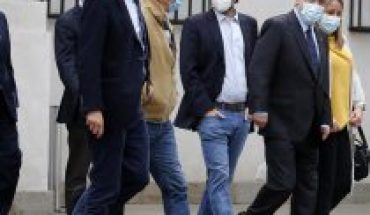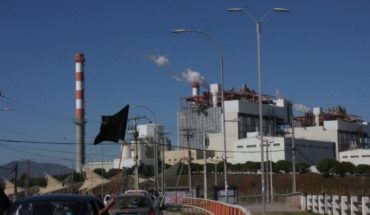Panama.- Several autistic children attend a Panama Pacific beach in the morning enjoy the breeze, the waves, and the sand while surfing, this as part of a therapy for autism spectrum disorder. The attendees of this therapy are children between 3 and 9 years old, who are awarded by their parents and instructors, while the little ones were carried away by the waves, who eventually calm them and bring out their cutest smiles.
Medical literature defines autism spectrum disorders as a developmental disability that can lead to significant social, communication, and behavioral problems.
Its two fundamental symptoms are: persistent deficiencies in communication and social interaction, and restrictive and repetitive patterns of behaviors, interests or activities.
Niñoe and instructor at sea. Photo: EFE
It’s a disability that is often “not seen, and that’s why it’s hard to tell something is going on,” he told Efe Paola Castrellón, the president and founder of Autism Wave, an organization that serves more than 400 children with autistic status.
Psychotherapist Anna Andreatta explained to Efe that surfing as an alternative therapy is of enormous use to these children, who have a sensory integration disorder.
When you take a little boy with autism spectrum disorder to water you bring untold benefits, which we can’t give in conventional therapies, she said.
First, water is a stimulus for the sense of touch, which is complemented by everything that means for the driving side to climb the children on a wave running board. The expert explained that “movement and swinging… the sensations of the board, the breeze”, stimulate the senses of children with autism spectrum disorder, who often have problems with social, emotional and communication skills. This therapy stimulates the senses propellerating (which intervenes in the development of the body scheme and in its relationship with space) and vestibular (which regulates the sense of movement and balance), which have as a benefit that “literally calms” children with autism spectrum disorder. The camp “Olas que calman” was organized by Autism Wave in Playa Serena, located about 90 kilometers from the Panamanian capital, and is one of four that develop throughout the year, Castrellón recounted.
Therapy at sea. Photo: EFE
It is an initiative that was born two years ago because a son of Castrellón, now 7 years old, has a severe autism condition and found no “places to recreate it.” But we found the beach and there was no turning back. The beach provides a positive energy. Contact with different textures (…) waves, surfing and movements provide release of sensory loads is important for these children. Sensory loads occur in the brain and the child is shared differently by releasing those loads,” he said. In addition, the camp allows children with autism spectrum disorder to “interact socially, because they communicate and interact with other people.” Autism Wave self-manages, has no sponsors and different camps are paid for by the parents of the boys. It is internationally backed by Surfershealing in California (USA), a pioneer in this activity with 25 years of experience, Castrellón explained.
Surfer Ricardo Solomon, originally from Venezuela, tells Efe about his experience as an instructor in the camps of the Panamanian organization, and recounts that it is clearly visible “how the waves change” the mood of children with autism spectrum disorder .” They come in nervous and come out with a smile and wave. That change was what inspired me to come the first time as a volunteer,” said Solomon, who has already participated in five autism camps Wave.La a father’s joy
Roberto Rangel, father of one of the participants in the Camp of Playa Serena, told Efe that he considers these activities “a rewarding experience” for him and “of great help” to his son.” Every time he comes he relaxes and it is a therapeutic experience for him. Before he did not like water, now that it is the fourth time (participating in the camp) he just goes and throws himself. She also cried when she climbed the surf board but no longer has that fear. My son is very cheerful and I’m proud of him,” he said. Speaking about his son’s life, Rangel says he “lives in a routine way, has always things in place” and has already learned to eat: “Before, he was afraid of being served food.” Information for parents and family of the patient with autism
Psychotherapist Andreatta stressed that it is essential that the parents of a minor with autism spectrum disorder inform the whole family, “because those little ones are going to be part of our lives.” Educating oneself first as a dad, understanding what this condition is that will accompany us for the rest of our lives, makes the information more digestible and that reaches the rest of the family,” he said. Autism spectrum disorder is not a disease, she emphasized the specialist, recommending parents to seek “real alternatives” to treat this condition.
We’re not looking for cures, this isn’t a disease. It’s a condition you have to learn to live with and give that condition its best alternatives to make it viable within your life, she said.
For them it is important that parents look for teams of professionals “that take them by the hand and feel a team that marries you and says ‘here I am and we will continue walking’. That makes all the difference,” the psychotherapist said. Spectrum disorder is in numbers
According to Data from the World Health Organization (WHO) for April 2018, one in 160 children worldwide has an autism spectrum disorder (ASD). In Panama there is no precise figure, among other reasons because in many cases the condition is not diagnosed, but according to figures from the Ministry of Health between 2013 and 2016 473 men and 156 women with autism were not diagnosed, most of them aged between 1 and 14 years.





